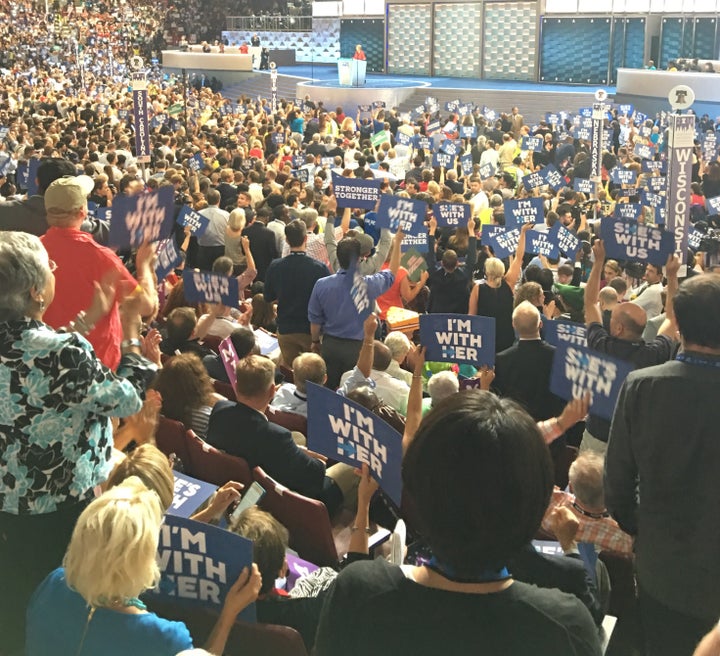
Clinton delegates show their support at the 2016 Democratic National Convention.
Contrary to popular belief, the United States (US) does not elect its president by popular vote. The electoral process involves 538 electors, colloquially called the Electoral College, whose sole function is to convene every four years to elect the president and vice president of the US.
The number of electors is determined by the number of national congressional districts - 538 - and a majority of 270 electoral votes is needed to secure the presidency. An elector is expected to vote for the candidate who won the popular vote in their state. In the event that a candidate does not reach the required majority, the 12th Amendment empowers the House of Representatives to choose the president-elect, but under such circumstances each state can only cast one unanimous vote.
Presidential campaigns understand the nuances associated with the electoral map better than anyone, and often prey on the uninformed. Campaign ads intentionally polarize the general electorate, drawing stark contrasts between two opposing candidates. Contentious campaign ads date back to America’s oldest print publications; however, the advent of a ubiquitous digital platform allows candidates to connect with voters in ways previously thought impossible.
According to the Pew Research Center, approximately 130 million Americans voted in the general election in 2012, which was in-line with voter turnout in 2008. Since the presidential election of 2000, at least 100 million voters cast ballots in each general election thereafter. While both parties enthusiastically tout GOTV campaigns, national voter turnout historically make little difference in the general election.
Imagine for a moment voter turnout jumps to 150 million voters nationwide this cycle. Such an increase has no bearing on the current electoral map. Texas will still cast 38 electoral votes and Wyoming will still cast 3. Now imagine voter turnout exceeds expectations immensly, and swells to 200 million voters. It still bears no meaningful fruit. California still casts 55 electoral votes, and West Virginia, 5.

2012 Electoral Map
The Electoral Map
The outcome of the general election is not a function of voter turnout per se, but rather a function of voter turnout in a specific state. Therefore, the logical calculation is to identify the states that matter, electorally speaking.
Since the presidential election of 2000, only 10 states can be identified as true swing states: New Hampshire, New Mexico, Nevada, North Carolina, Colorado, Ohio, Iowa, Indiana, Florida, and Virginia. The remaining 40 states have voted for the same party in each election since 2000. Assuming both vice presidential candidates carry their home states, Indiana and Virginia can be removed from the list, which leaves a mere eight states to dissect.
Upon analysis of the remaining eight states, only two - North Carolina and Flordia - are likely to break for Donald Trump. President Obama carried the six remaining states in 2012, and Trump has done little to make inroads with those constituencies. In fact, it can be argued that Trump has done more harm than good in these pivotal states.
Consider New Mexico and Nevada. Trump has alienated Hispanic and pro-immigration supporters with his frequent use of harsh, nativist rhetoric. In Ohio, the negative effects of Trump’s personal attacks on the beloved Republican governor John Kasich, who it is important to note has not endorsed Trump, continues to linger from the primary season. That leaves New Hampshire, Colorado, and Iowa; three states that have become increasingly liberal over the last decade.
Assume for a moment Trump outperforms the polls and carries New Hampshire, Colorado, Ohio, and Florida in November. Clinton would still net 272 electoral votes and secure the White House. Simply put, there is no likely path to victory for Trump, save a political hat trick that must include Ohio, Florida, and Pennsylvania.
Trump’s campaign is well aware of the challenge it faces with regard to the electoral map, despite the campaign’s aloof, dismissive, and often condescending tone. Trump’s campaign manager, Kellyanne Conway, frequently downplays the campaign’s electoral map challenges while making rounds on the major television networks.
To the apathetic voter, Trump’s divisive and inflammatory statements seem unpresidential, bigoted, and downright delusional. To the uninformed voter, Trump’s campaign is a nationalist call to action. To the few who glean deeper and discern the political forces at play, Trump’s campaign appears far more sinister than first realized. It reeks of an era reminiscent of a bourgeoisie class that methodically preyed on the proletariat for financial gain. In true Roman fashion, Trump seems to have mastered the art of rhetoric, often manipulating his delivery to meet the demands of his bloodthirsty constituents.
The Apprentice
At its height, The Apprentice attracted over six million viewers who tuned in faithfully to get their weekly Trump fix. He presented himself as a knowledgeable, charismatic, straight-talking business mogul. He appeared to foster a genuine connection with his audience emotionally, despite having nothing in common with the program’s blue-collared base.
There was a moment in time, somewhere between The Apprentice getting canned and Trump’s first primary debate, when the politically adept recognized Trump’s true motive, which wasn’t political at all. Wonks nationwide came to the realization that Trump was not campaigning for President, but rather was, and still is, hell-bent on exploiting a specific voting bloc for personal gain. He has tapped into his supporters’ frustration, rage, and longing to be heard, by aggressively fanning the flames of division, dissension, and disorder. The result: bigger rallies, bigger exposure, bigger publicity.
Trump views the presidential campaign as a business tactic designed specifically to catalyze the growth of his brand. His national campaign has become a stimulus package for his overexposed brand. Trump’s audience of six million viewers garnered decent television ratings a decade ago, but six million viewers has ballooned to 13 million supporters, and now serve as the lifeline sustaining his anemic business empire. While undeniably business-savvy, Trump’s campaign strategy is detrimental to the moral fabric of society and to the political system as a whole.
Inciting violence, encouraging misogyny, and abandoning all decorum is generally a bad political calculation, but one that has paid dividends in the entertainment arena. If Trump continues to target a specific niche for the sole purpose of growing his brand, he stands to gain considerably, financially speaking, despite lacking the electoral support needed to attain the requisite votes to win the general election.
Trump may have more to gain by losing, which is a reality one would assume the Ivy-league graduate has considered. In a loss, he eludes the responsibility of making good on his hollow campaign promises, while continuing to reap the benefits of his increased celebrity. A loss also helps Trump dodge the arduous task of governing, and ensures that he will never again be forced to engage in a serious conversation centering on policy and social responsibility. He could remain a bombastic, outspoken demagogue who profits from his historic presidential run; and he’ll broadcast it all on Trump TV. Unfortunately, it will be at the expense of the American people.
